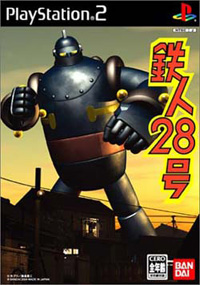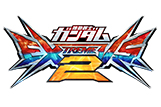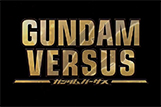Reviews: Tetsujin 28-go (8/10)
Posted on : 06-09-2009 | By : Cacophanus | In : Reviews
Hardware: PlayStation 2
2
 In 1956, a certain Mitsuteru Yokoyama penned a manga by the name of “Tetsujin 28-go”. This manga portrayed the life of a young boy called Shotaro Haneda, remote controlling a huge military robot called Tetsujin 28-go to thwart the forces of evil and do good in the world. It wasn’t very long before this manga made the transition to anime, and then jumped the Pacific Ocean to mesmerise the US populace (under the new name of “Gigantor”). It’s important to clarify one thing from the start: Mitsuteru Yokoyama’s “Tetsujin 28-go” was single-handedly responsible for the creation of Japanese mecha pop-culture. His work has inspired generations of people. Some of these people happen to work at a Japanese developer called Sandlot.
In 1956, a certain Mitsuteru Yokoyama penned a manga by the name of “Tetsujin 28-go”. This manga portrayed the life of a young boy called Shotaro Haneda, remote controlling a huge military robot called Tetsujin 28-go to thwart the forces of evil and do good in the world. It wasn’t very long before this manga made the transition to anime, and then jumped the Pacific Ocean to mesmerise the US populace (under the new name of “Gigantor”). It’s important to clarify one thing from the start: Mitsuteru Yokoyama’s “Tetsujin 28-go” was single-handedly responsible for the creation of Japanese mecha pop-culture. His work has inspired generations of people. Some of these people happen to work at a Japanese developer called Sandlot.
Tetsujin 28-go is Sandlot’s third mecha game, and the first time they have been allowed to tackle possibly the most prestigious of mecha icons. Their first outing – Remote Controlled Dandy on the Psone – was impressive and unique, having the player control a huge mecha from ground level and having them position themselves accordingly – after all, you were the camera. The second attempt was Gigantic Drive (on PS2), which was essentially “Remote Control Dandy Deluxe”. Both of these games had an amazingly intricate control system where each limb was controlled individually. Whilst this was a comprehensive approach, it had an obviously steep learning curve.
Tetsujin 28-go still has the unique camera implementation in full effect but the controls have been massively simplified. Instead of controlling limbs individually and calling upon monumental levels of multitasking from the player, we now have a simple and intuitive system for movement and combat. The left analogue stick controls all directional movement, but with one important caveat: the directional control of Tetsujin 28-go is done entirely from his perspective, in that pushing the left analogue stick will mean that Tetsujin will move forward irrespective of Shotaro’s point of view. This can and does have its difficulties – after all, most of the gameplay is frenetic in pace, so the combat has to be precise and decisive. This means that many people will take a fair amount of time to get used to the camera system. Whilst the system is limited, it is that way for one very good reason, however: it’s simulating how the situation would be in real life. In that respect, the viewpoint is very immersive and very impressive (especially when the sense of scale is literally hammered home), but a tad daunting to newer players not fully briefed on the mecha mythos.
The irony of all this camera nonsense is that after extended play and familiarisation with how the combat works, the problems are pretty much transparent and actually aid the sense of immersion. More importantly, the camera coerces the player into thinking tactically about how they dispose of their next mechanical enemy, leaving the onus on repositioning yourself accordingly.
This brings us onto the combat in Tetsujin 28-go, and whilst it superficially appears rather simplistic there is a great level of gameplay depth for the player to utilise. There are three dials that are displayed on Shotaro’s retro-styled controller (which is part of the game’s HUD). The left dial represents the left arm and is controlled with the square button, whereas the right dial represents the right arm and is controlled via the circle button. By “controlled”, this means that once the respective button is depressed, the arm pulls back ready for a punch. There are four stages of each punch, which is signified by the dial’s changing colour (though the last stage is only depicted by an aural cue). This means that both arms can be very simply comboed together to unleash a pretty fatal barrage of punches. There is one dial left on Shotaro’s controller however, that is possibly the most important of all.
The middle dial represents Tetsujin 28-go’s special attack and is controlled via the triangle button. Again there are four stages of the dial, but each stage represents an utterly different special attack. There is nothing quite as satisfying as unleashing a selection of well timed punches and then following up with a flying kick. Mastering Tetsujin 28-go’s array of special attacks are vital for progress, especially in the latter half of the main campaign mode. As if this wasn’t enough, Tetsujin 28-go can pick up buildings and hurl them at the enemy. This is undertaken via the same method that allows the player to pick up Shotaro and cradle him in his palms, and if the player is deft enough a fair few unsuspecting villains can also be clenched in the iron fists of this heroic mecha and then flung great distances.
The combat is very clever and it does take skill to position yourself, charge up a few punches, combo them and then finish with a flamboyant special attack. It’s all great fun to pull that stuff off. Lobbing buildings at these mechanical demons is as satisfying as it is fun (and necessary against foes such as Black Ox).
As if this wasn’t enough, the game also offers up to four-player versus action. This is an utterly excellent feature, because not only does it highlight the genius of the game’s combat system but also allows the player to utilise many different robots (rather than just Tetsujin 28-go). After all, how many games offer you the chance to pick up a huge warehouse, boost up into the air with said warehouse, land in the thick of a brawl between three of your friends and then smack them over the head with that sizeable amount of industrial rubble? The size of the maps can be a problem with the camera if opponents get too far apart, though. The camera zooms out making it difficult to see exactly what is going on but, considering the action occurs in close quarters, this problem is pretty much moot.
A huge amount of love has been poured into this game, not only in terms of replicating fictional events in gameplay terms, but also nailing that retro anime aesthetic. It is also a huge game with a vast story mode, a suitably cathartic challenge mode and a very addictive power-up system. Unlike Gigantic Drive, Tetsujin 28-go doesn’t muck about with long cutscenes and one-on-one combat. Instead, it’s full-on action against multiple foes.
It is a strange irony that almost fifty years after the original release of Tetsujin 28-go, we mere mortals can actually experience the thrill of controlling creator Mitsuteru Yokoyama’s vast mechanical behemoth first-hand… and a cruel one that he never lived to see this excellent game for himself.
Tamashii: 8/10











>Tetsujin 28-go is Sandlot’s third mecha game
Readers should notice that they later went on to create the excellent Nintendo DS game “Chousoujuu Mecha MG”. It ditched the human/robot character differentiation but featured an equally impressive and exciting control scheme, filling the touchscreen with lots of buttons and gears and levers to fiddle with.
Indeed, we’ve already written a feature about Sandlot’s various mecha games (including Mecha MG). You’ll find though that Tetsujin 28-go is actually Sandlot’s fourth mecha game:
http://www.mechadamashii.com/features/features-an-ode-to-sandlot/